Microsoft dynamics NAV administration
Bạn đang xem bản rút gọn của tài liệu. Xem và tải ngay bản đầy đủ của tài liệu tại đây (12.42 MB, 208 trang )
Microsoft Dynamics NAV
Administration
A quick guide to install, configure, deploy,
and administer Dynamics NAV with ease
Sharan Oberoi
Amit Sachdev
professional expertise distilled
P U B L I S H I N G
BIRMINGHAM - MUMBAI
Download from Wow! eBook <www.wowebook.com>
Microsoft Dynamics NAV Administration
Copyright © 2010 Packt Publishing
All rights reserved. No part of this book may be reproduced, stored in a retrieval
system, or transmitted in any form or by any means, without the prior written
permission of the publisher, except in the case of brief quotations embedded in
critical articles or reviews.
Every effort has been made in the preparation of this book to ensure the accuracy of
the information presented. However, the information contained in this book is sold
without warranty, either express or implied. Neither the authors, Packt Publishing,
nor its dealers or distributors will be held liable for any damages caused or alleged to
be caused directly or indirectly by this book.
Packt Publishing has endeavored to provide trademark information about all the
companies and products mentioned in this book by the appropriate use of capitals.
However, Packt Publishing cannot guarantee the accuracy of this information.
First published: September 2010
Production Reference: 1170910
Published by Packt Publishing Ltd.
32 Lincoln Road
Olton
Birmingham, B27 6PA, UK.
ISBN 978-1-847198-76-1
www.packtpub.com
Cover Image by Sandeep Babu ()
Download from Wow! eBook <www.wowebook.com>
Credits
Authors
Editorial Team Leader
Sharan Oberoi
Gagandeep Singh
Amit Sachdev
Project Team Leader
Reviewers
Ashwin Shetty
Dhan Raj Bansal
Tony Hemy
Acquisition Editor
Sarah Cullington
Development Editor
Reshma Sundaresan
Technical Editors
Indexer
Monica Ajmera Mehta
Proofreader
Sandra Hopper
Production Coordinators
Arvindkumar Gupta
Kruthika Bangera
Gaurav Datar
Manjeet Kaur Saini
Cover Work
Arvindkumar Gupta
Copy Editors
Janki Mathuria
Sanchari Mukherjee
Download from Wow! eBook <www.wowebook.com>
Foreword
The Microsoft acquisition of Navision in 2002 changed this world-class ERP solution
forever. Microsoft’s deep R&D and extensive partner network fueled NAV into
the fastest growing mid-market ERP globally. Hallmarks of Navision are its ease
of installation, configuration, and use. Its strong architecture, layered development
platform, and user-friendly interface enables quick ROI and high end-user adoption.
From simple origins, NAV has grown into a fully scalable, robust application with
strong positioning among the top-tier ERP products. The recent release of the
RoleTailored client enables step-level changes in user adoption and productivity.
More and more international businesses are adopting NAV, either as a hub and
spoke model, or as an enterprise ERP application.
This book highlights some key areas of Dynamics NAV and the corresponding
integration of other Microsoft technology. The book will appeal to beginners,
users, and partners alike.
Dave Miller—General Manager, Microsoft Canada (MBS)
About Dave Miller
Dave Miller is the GM of MBS Canada. His team is responsible for driving
the growth of the ERP and CRM businesses.
Dave has been in the IT industry for 23 years. His career has spanned services,
outsourcing, infrastructure, and software. Dave has held positions of increasing
responsibility with leading IT firms including Xerox, EMC, and most recently SAP,
where he was Regional VP for Central Canada.
Dave holds an Honors Commerce degree from Laurentian University and a Bachelor
of Science Degree in Computer Science from Brock University.
Download from Wow! eBook <www.wowebook.com>
About the Authors
Sharan Oberoi is a seasoned Microsoft Dynamics professional and has more than
11 years of experience working as an architect, consultant, and business leader for
Microsoft Dynamics products. He works for Tectura in an advisory role.
He has helped various organizations with large-scale, global, successful
implementations of Microsoft Dynamics NAV. Sharan has also built and grown
high-performing, culturally diversified, and geographically dispersed consulting
teams. At the start of his Microsoft Dynamics career, Sharan was an instrumental
startup team member for Microsoft Dynamics NAV (Navision) in India. He led
a small team to localize and release Microsoft Dynamics NAV in India and
subsequently evangelize Microsoft Dynamics NAV across the newly established
partner channel in India.
Sharan worked as a consultant for a few US-end clients before moving to
New Zealand. He gained his Big 4 consulting experience while working for
Ernst & Young in New Zealand for a few years. In 2007, he moved to Vancouver,
Canada with his family and started working as a team leader for Tectura. While at
Tectura, Sharan has handled diverse roles and has been involved in various product
teams and global clients, with complex, high-risk product implementations and
application rollouts.
Having worked for organizations such as Tectura, Ernst & Young, and Navision
(now Microsoft), Sharan has lived and worked in a dozen or more countries,
touching almost every continent. He has worked with clients from diverse industries
including ports, financial services, agri businesses, energy and power generation,
shipping, and so on.
Download from Wow! eBook <www.wowebook.com>
I believe my Thanks section would go longer than my own profile.
I've taken so much from so many people in terms of love, support,
knowledge, experience, and so on, that it would be unfair to miss
any of them.
I would like to thank my wife Gurvinder for her unconditional
support in this project. While I was busy toiling away for the last few
months to write this book, she's been busy juggling her own work,
taking care of our two beautiful kids, and helping me write this
book. I hope I am able to compensate the time I stole from her quota.
Big thanks to my Dad, Mom, and Sister for believing in me and
providing me with a rock-solid support and value system to live an
honest and positive life, full of love, and giving me the confidence to
always take the right path.
Thanks to all my friends and family who have been with us for so
many years and to those who have supported me throughout the
writing of this book.
Thanks a lot to my dear friend and coauthor of this book, Amit
Sachdev, for his endurance, support, and knowledge for finishing
this book.
I would like to express my sincere gratitude to Terry Petrzelka,
Lisa Mathias, Vince Castiglione, Chris Harte, Chuck Famula, Kathy
Nohr, Naeem Shafi, Tara, and Michael Hamby from Tectura, Claus
Hamann from the ex Ernst & Young NAV team and Harmeet Singh
from Microsoft for their encouragement and support during the
writing of this book and otherwise.
I cannot thank enough, the late Mr. Yash Nagpal for keeping faith in
my abilities and giving me some of the most important opportunities
in the early years of my career.
For the many nights that I have not been able to tuck you both into
bed and for the long winter evenings that I have not been able to
play with you, while I was finishing up this book—this work is
dedicated to the two precious jewels of my life Kudrat and Nimar.
Download from Wow! eBook <www.wowebook.com>
Amit Sachdev works as a Technology Advisor for Dynamics products and the
lead for SureStep methodology programs at Microsoft Canada. He is responsible
for "Dynamics" product awareness, strategic engagement with Microsoft partners,
building successful Dynamics practices, and ensuring the use of best principles for
partners around delivery and implementation methodologies.
Amit has diverse professional experience, and in the past has worked in
various capacities including advisory consulting, management, designing,
and implementing business solutions in many countries, spanning across
various industries and market segments.
He holds an Engineering degree in Electronics and various awards and certifications
in both Microsoft and non-Microsoft technologies. Apart from his eminence as a
seasoned "Dynamics" professional, Amit has also been instrumental in providing
strategic direction to various startups and sits on the board and advisory panels
of various non IT and IT-related companies.
I want to thank everyone who graciously agreed to help me in
completing this book. I wouldn't have been successful without the
support from my colleagues, my team, family, and friends who've
always been there for me.
Although my list would be endless, I would particularly like to cite
(in alphabetical order), Al Fournier, Brad Pawlak, Dan Brown, Dave
Miller, Flemming Klaussen, Harmeet Singh, John MacDonald, Joyce
Lafleur, Monica Sarna, Morris Mele, Raouf Kishk, and Vishal Rajput
for their endless help and motivation.
I would be remiss if I did not convey my special gratitude to my
friend and ex-colleague, Martin Beechener, Sharan Oberoi (the
co-author of this book), and Tony Hemy (reviewer of this book)
for their contribution, knowledge, and continuous support.
Last, but not least, my special thanks to my parents, my wife, my
sister, and my lovely son, who have always believed in my abilities
and provided me with all the love and happiness in life.
Download from Wow! eBook <www.wowebook.com>
About the Reviewers
Dhan Raj Bansal graduated in Electronics & Instrumentation Engineering from
Kurukshetra University. After scoring All India Rank 6 in the national-level entrance
test called GATE (Graduate Aptitude Test in Engineering) in 2003, he
got through in prestigious Indian Institute of Science, Bangalore (India) in
M.Tech (Instrumentation Engineering). In 2005, he started his professional
career as Navision Technical Consultant with PwC, India.
Currently Dhan Raj works as a Freelance NAV Developer and Business Analyst. He
has worked for clients in the US, UK, Denmark, Australia, Dubai, Nigeria, and India.
Dhan Raj is an active member of the online communities for NAV, such as
dynamicsuser.net, mibuso.com, and the online forums managed by Microsoft. For
his contributions to these online communities, he received the Microsoft Most Valuable
Professional (MVP) Award in July 2010. The MVP Award is given out by Microsoft to
independent members of technology communities around the world, and recognizes
people that share their knowledge with other members of the community.
Dhan Raj lives with his family in Gurgaon, India. He loves mathematics
and solving puzzles.
Tony Hemy started working with Navision Financials straight out of secondary
school in 1998 in Southampton, England.
In the years since, he has travelled the world developing and deploys Dynamics
NAV in three Microsoft regions (North America, Asia Pacific and Europe, Middle
East and Africa) and over a vast variety of industries.
Tony spent six years as a reserve soldier in the UK, the only break in his 12-year
NAV career coming as a six-month United Nations peacekeeping tour in
Cyprus with the British Army's Royal Regiment of Artillery.
Currently living in Vancouver, Canada as the Senior NAV Consultant at The RSC
Group, Tony's work includes designing with Dynamics NAV code, as well as
visioning and consulting.
Outside of work Tony enjoys mountaineering and rock climbing.
Download from Wow! eBook <www.wowebook.com>
Table of Contents
Preface1
Chapter 1: Setting up the Environment for Dynamics NAV
5
Considerations for deploying Dynamics NAV
Understanding the business needs of company
Factors to be considered for configuring a role
6
7
8
Exporting the reporting and Business Intelligence requirements
10
Single or multisite deployment
14
Other DB aspects to consider while deploying
15
Integration with external systems and third-party add-ons
17
Exploring hardware, operating systems, and networking requirements
19
Getting to know the Inherent BI capabilities in NAV
Other BI tools—Business Analytics with NAV
Choice of using a single versus multi-database for deployment
Inter-company operability
Integration with other systems in headquarters
Data ports and XML ports
Navision Application Server also known as "NAS"
Integration using Web services
Dynamics NAV client
Dynamics NAV server
Using NAV in WAN configurations
Networking
10
12
14
15
16
18
18
18
19
19
20
21
Summary21
Chapter 2: Installing Dynamics NAV
Installing a Classic client
Installing a C/SIDE database server
Preparing a Microsoft SQL Server database for Dynamics
NAV installation
Connecting a Dynamics NAV client (Classic) to the NAV
Classic database server
Download from Wow! eBook <www.wowebook.com>
23
23
28
35
39
Table of Contents
Connecting a Dynamics NAV client (Classic) to a Microsoft
SQL Server database
40
Installing the RoleTailored client for Dynamics NAV
41
Installing the Dynamics NAV server (the middle-tier component)
44
Connecting a RoleTailored client to the database
45
Summary46
Chapter 3: Integrating Dynamics NAV with the Microsoft Platform 47
Integrating Dynamics NAV and the Microsoft Office system
MS SharePoint interface
Installing and setting up Microsoft Dynamics NAV Employee Portal
Installing Employee Portal
Installing other required software
Installing Employee Portal frontend components
Setting up captions
47
48
48
49
51
51
54
Exporting documents to MS Excel and MS Word
56
Using extensibility with NAV 2009 SP1
60
Creating a Customer Card stylesheet for MS Word
Creating a Mail Merge with the Customer Card stylesheet
Using a control add-in on pages
Example of using an add-in on RTC
Creating add-ins
Registering the add-in in Microsoft Dynamics NAV
57
59
60
61
61
64
Summary67
Chapter 4: Securing Dynamics NAV Applications
Security with SQL Server installation
Dynamics NAV security models
Switching between Enhanced and Standard security models
Why synchronize?
Synchronizing one or multiple users
Users, logins, and passwords
Creating database logins
Setting up user accounts
How is a USER ID used across the application
Logging in using Windows Authentication
SQL extended stored procedures
Why use Windows Logins?
69
70
70
71
71
72
72
73
74
75
76
76
79
Passwords
Roles and permissions
Assigning permissions
Creating a new user from scratch
Security filter—record-level security
Sarbanes Oxley compliance
Security, backups, and authorization
[ ii ]
Download from Wow! eBook <www.wowebook.com>
79
80
82
85
87
87
87
Table of Contents
Access control and audit trail
88
Change Log
89
Data validation and accuracy
90
Effective change management
90
Summary91
Chapter 5: Backing up and Restoring a Dynamics NAV Database 93
Creating and restoring backups using a Dynamics NAV client
93
Retrieving a backup of the Dynamics NAV database
93
Restoring the database
95
Handling error messages
96
Using HotCopy backup
96
Testing the database
98
Starting the test
99
Viewing the output of the database
100
Backing up and restoring with SQL Server
101
Creating a server-side SQL backup
102
Restoring the SQL backup
104
Synchronizing a SQL database
107
Expanding the database
107
Things to consider while defining the backup strategy
109
Summary110
Chapter 6: Performance Tuning
Configuring a SQL Server database for Microsoft Dynamics NAV
Defining database and transaction log files
Defining rules using collations
Writing less expensive C/AL code for customizations
Retrieving data using FINDFIRST/FINDLAST/FINDSET
Using the NEXT statement
Using ISEmpty
Locking the recordset
Disabling the "find-as-you-type" feature
Fine-tuning the SQL Server database for Dynamics NAV
SIFT
Using indexes/keys in Dynamics NAV
Investigating the performance of the database
Updating statistics
The Index Defrag tool
The Key Information tool
Session Monitor
Optimizing tables from the Dynamics NAV interface
111
111
112
112
113
113
114
114
115
116
116
116
118
120
120
120
123
126
126
Summary127
[ iii ]
Download from Wow! eBook <www.wowebook.com>
Table of Contents
Chapter 7: Setting up Periodic Activities, Stylesheets,
and Rapid Implementation Methodology
Job Queue
Setting up Job Queue
Common batch jobs
Recurring journals
Creating a Reminders batch job
Adjust Exchange Rates batch job
129
129
130
132
133
134
135
Managing stylesheets in Dynamics NAV
136
Rapid Implementation Methodology
145
Using RIM tools to set up a new company
145
Summary149
Chapter 8: Updating Objects and Virtualization with
Dynamics NAV
Objects in NAV
Updating objects
Exporting the objects from NAV
Importing a file with modifications
151
151
152
152
154
Virtualization with Dynamics NAV
157
Advantages of virtualization
157
Dynamics NAV and application virtualization
159
Summary160
Chapter 9: Business Intelligence
Importance of Business Intelligence
The Microsoft Business Intelligence story
Business Intelligence categories overview
Business Intelligence product scenarios
Dynamics NAV and Business Intelligence
Inherent BI capabilities in NAV
Business insight through the Role Center
Activities section
My Customers/Items/Vendors
My Notifications
Graphical charts and ad hoc analysis
Creating charts for the Role Center home page
[ iv ]
Download from Wow! eBook <www.wowebook.com>
161
162
162
163
163
165
165
165
166
166
167
168
170
Table of Contents
Reporting capabilities in NAV
173
Defining the data model
173
Defining relationships between tables
174
Defining the relationship between the tables
176
Defining the layout
177
Selecting the matrix
177
Testing the report
180
Summary181
Index183
[v]
Download from Wow! eBook <www.wowebook.com>
Download from Wow! eBook <www.wowebook.com>
Preface
Microsoft Dynamics NAV is an Enterprise Resource Planning (ERP) software
product that integrates financial, manufacturing, supply chain management, sales
and marketing, project management, human resources, and services management
information from across your organization, into a centralized database. It can take
hours to browse through documentation and references available online to learn
how to install, configure, deploy and administer Dynamics NAV. This book aims
to offer quickstart information in one place.
You will be amazed to find out how easily you can administer Dynamics NAV using
this quick step-by-step guide. This book also has recommendations for software and
hardware requirements, including operating system considerations and hardware
considerations for administering Dynamics NAV to your advantage. It covers some
advanced functions to set up periodic activities, common batch jobs, and create
object files. It will also guide you to secure your database by creating backups
and improve performance with practical examples.
What this book covers
Chapter 1, Setting up the Environment for Dynamics NAV, as the name suggests,
is all about how we can set up the environment for Dynamics NAV, what the
prerequisites are, among other things.
Chapter 2, Installing Dynamics NAV, discusses 5.0 SP1 Dynamics NAV C/SIDE client
installations, followed by installation of a C/SIDE database server. It also walks us
through the process of installing the Dynamics NAV 2009 RoleTailored client and
also the Dynamics NAV server.
Chapter 3, Integrating Dynamics NAV with the Microsoft Platform, shows how Dynamics
NAV is integrated with the rest of the Microsoft Stack, including SharePoint and
other Office applications.
Download from Wow! eBook <www.wowebook.com>
Preface
Chapter 4, Securing Dynamics NAV Applications, talks about security, roles,
permissions, and other related topics for the Dynamics NAV application.
Chapter 5, Backing up and Restoring a Dynamics NAV Database, helps us create a backup
and restore it using the Dynamics NAV client. It also looks at how to handle error
messages encountered while restoring.
Chapter 6, Performance Tuning, is all about configuring a SQL Server database for
Microsoft Dynamics NAV by defining database and transaction log files, configuring
RAID 10, and defining rules using collations. It also looks into fine-tuning the
performance of the database for Dynamics NAV by using Sum Index Flow
Technology, and by accessing and modifying the properties of the indexes. Finally,
the chapter also discusses identifying and troubleshooting performance issues by
updating the statistics and using the tools available in SQL Resource Kit.
Chapter 7, Setting up Periodic Activities, Stylesheets, and Rapid Implementation Methodology,
starts with how to set up recurring jobs, which can be run automatically at a preset
time and a set frequency. It then speaks about the functional aspect and some of the
most common batch jobs that are required in business. The final part talks about rapid
implementation in NAV.
Chapter 8, Updating Objects and Virtualization with Dynamics NAV, speaks about
what virtualization is, its types, and advantages. It then helps us understand how
Dynamics NAV is supported in virtualization.
Chapter 9, Business Intelligence, starts with what Business Intelligence is, its categories,
and product scenarios for each category. It then moves to the inherent BI capabilities
in Dynamics NAV. Finally, it walks us through steps for designing reports in NAV
2009 and testing them.
Who this book is for
If you want to get started in administering Dynamics NAV, this book is
for you. Readers need not have any previous experience with Dynamics NAV.
Conventions
In this book, you will find a number of styles of text that distinguish between
different kinds of information. Here are some examples of these styles, and an
explanation of their meaning.
Code words in text are shown as follows: "Once we have copied the client files,
use fin.exe or finsql.exe to run the appropriate version of Dynamics NAV."
[2]
Download from Wow! eBook <www.wowebook.com>
Preface
When we wish to draw your attention to a particular part of a code block,
the relevant lines or items will be shown in bold:
IF GLEntry.FINDSET THEN
REPEAT UNTIL GLEntry.NEXT = 0;
Any command-line input or output is written as follows:
Copy sn.exe -T <assembly>
New terms and important words are shown in bold. Words that you see on the
screen, in menus or dialog boxes for example, appear in our text like this: "There
are two options available while installing the Dynamics NAV Classic database
server—Typical and Custom."
Warnings or important notes appear in a box like this.
Tips and tricks appear like this.
Reader feedback
Feedback from our readers is always welcome. Let us know what you think about
this book—what you liked or may have disliked. Reader feedback is important
for us to develop titles that you really get the most out of.
To send us general feedback, simply send an e-mail to ,
and mention the book title via the subject of your message.
If there is a book that you need and would like to see us publish, please send
us a note in the SUGGEST A TITLE form on www.packtpub.com or e-mail
If there is a topic that you have expertise in and you are interested in either writing
or contributing to a book, see our author guide on www.packtpub.com/authors.
Customer support
Now that you are the proud owner of a Packt book, we have a number of things
to help you to get the most from your purchase.
[3]
Download from Wow! eBook <www.wowebook.com>
Preface
Downloading the example code for this book
You can download the example code files for all Packt books you
have purchased from your account at ktPub.
com. If you purchased this book elsewhere, you can visit
and register to have
the files e-mailed directly to you.
Errata
Although we have taken every care to ensure the accuracy of our content, mistakes
do happen. If you find a mistake in one of our books—maybe a mistake in the text or
the code—we would be grateful if you would report this to us. By doing so, you can
save other readers from frustration and help us improve subsequent versions of this
book. If you find any errata, please report them by visiting ktpub.
com/support, selecting your book, clicking on the errata submission form link, and
entering the details of your errata. Once your errata are verified, your submission
will be accepted and the errata will be uploaded on our website, or added to any
list of existing errata, under the Errata section of that title. Any existing errata can
be viewed by selecting your title from />
Piracy
Piracy of copyright material on the Internet is an ongoing problem across all media.
At Packt, we take the protection of our copyright and licenses very seriously. If you
come across any illegal copies of our works, in any form, on the Internet, please
provide us with the location address or website name immediately so that we can
pursue a remedy.
Please contact us at with a link to the suspected
pirated material.
We appreciate your help in protecting our authors, and our ability to bring
you valuable content.
Questions
You can contact us at if you are having a problem
with any aspect of the book, and we will do our best to address it.
[4]
Download from Wow! eBook <www.wowebook.com>
Setting up the Environment
for Dynamics NAV
Choosing an Enterprise Resource Planning (ERP) solution in today's competitive
landscape is not an easy task. A good ERP system is the one, which is rich, robust,
and yet flexible to suit current and changing business needs.
Businesses have changed fundamentally in the past decade. Everything from
processes to reliance on technology has changed the face of today's businesses.
The use of information has become more crucial in fast-changing market trends.
The genesis of ERP, CRM, and Business Intelligence systems have made it possible
to have business data and information available when, where, and how we need it.
In general the ERP system is referred to as an application or a set of applications
and tools that integrate various functions and processes of a company into a single
IT system. However, the common perception holds that these systems are fairly
expensive and complex. In fact, various studies indicate that more than 50 percent of
users already licensed to use these systems never use them. This means a significant
amount of a company's investment is wasted on the initial and recurring costs
of these systems. The reasons can vary from the choice of a wrong or inherently
complex system, highly customized and non-upgradable implementation, to a lack
of training, and so on. However, the fundamental piece of an effective business
system lies in an imperative synergy between people and processes. These are two
significant pieces in every business. While most ERP applications are limited to
electronically transforming processes, Microsoft's vision has been to provide a robust
business platform by bringing these two worlds together—the world of people and
the world of processes.
Download from Wow! eBook <www.wowebook.com>
Setting up the Environment for Dynamics NAV
This can be achieved by combining various aspects. First is a seamless connectivity and
integration among various technologies, embedding various pivotal points of personal
productivity applications into process systems such as accounting applications or
warehouse systems and vice versa. For example, a graphical cost analysis report that
tells us about the increasing trend of raw material costs on our mobile device every
day, can help us in restrategizing our purchases for the next few months, or creating
orders in MS Excel, or simply getting business reports in MS Outlook.
The second aspect is empowering people by giving them the right tools and
information they need and making tasks simpler by removing unnecessary and
overwhelming information they never use. For example, the information and tools
required by a CEO of a company are very different from that of a warehouse worker.
However, each business is different and are the roles and responsibilities of people
in a business. Therefore, the first and foremost consideration in an ERP deployment
is a careful assessment of these roles, functions, and how the ERP system is aligned
to them.
In Dynamics NAV, this is achieved by providing a RoleTailored experience to users.
The first aspect of seamless connectivity is discussed in the later parts of the book.
In this chapter we will focus on the second aspect, which is providing a RoleTailored
experience to users and other considerations in deploying NAV.
Considerations for deploying
Dynamics NAV
Every organization is different, and so are the deployment requirements of the
ERP system. Hence, before deployment of Dynamics NAV, various aspects
must be considered, such as the size of the organization, functions of teams and
individuals, how they intend to use the system, single or multi-site structure, network
requirements, hardware configurations, and so on. We'll start with the first aspect,
which is business needs or how the teams and people in our company use the system.
[6]
Download from Wow! eBook <www.wowebook.com>
Chapter 1
Understanding the business needs
of company
Business needs vary for every company and also in every department in a company.
As Dynamics NAV is a highly scalable and flexible solution, the deployment
requirements can vary extensively between smaller organizations with simple
processes versus bigger and more complex operations.
The first and foremost consideration is to decide which areas of our organization
will use Dynamics NAV and at what levels. The User Interface design of Dynamics
NAV 2009 is centered on the RoleTailored principles. Therefore, before installation
and deployment it's important to understand the role of each user or user group,
functions they will perform using NAV, and the information they will need. Dynamics
NAV comes with various standard user roles. These user roles can be configured,
customized, and personalized based on the role group or individual's requirements.
RoleTailored functionality strips away functions that users don't need. This removes
unnecessary distractions in their work and brings the information and features they
need to the forefront of the system. This helps prioritize tasks and helps users to
become more productive in their daily tasks.
Microsoft invested a large amount of resources into finding out what people did in
their jobs and how they performed the tasks. The result was that they defined distinct
job roles covering essential job functions in areas such as Finance, Sales, Marketing, IT,
Manufacturing, and Customer Service. Each job role has a defined list of the functions
and features that the individuals need in order to perform their tasks.
Microsoft Dynamics NAV comes with 21 Role Centers out of the box and these
are designed to cover the main job roles within a company. However, each user
is not restricted to one Role Center and any Role Center can be modified to suit a
company's processes.
[7]
Download from Wow! eBook <www.wowebook.com>
Setting up the Environment for Dynamics NAV
The following screenshot represents a typical Role Center in NAV. It shows the
Role Center of a "Production planner". Put simply, a Role Center in NAV is a user's
personal space in NAV. It shows the most tasks a user usually performs and analysis
the user needs, along with the concise information the user needs for his/her role in
the company.
Factors to be considered for configuring a role
The following factors must be considered when configuring a role:
•
Pages required for a role, for example, the Item Card page or a sales
order page
•
Structure of the home page and critical or optional information required
on the home page
•
Procedures and processes required by a role, for example, approval process
and more
•
Structure of other important pages required for the role
The following screenshots describe how an Item Card page differs significantly
for two different roles in a company:
[8]
Download from Wow! eBook <www.wowebook.com>
Chapter 1
[9]
Download from Wow! eBook <www.wowebook.com>
Setting up the Environment for Dynamics NAV
Exporting the reporting and Business
Intelligence requirements
Business Intelligence (BI) is a mechanism for collecting, analyzing, and providing
data using various technologies and systems in order to help business have more
visibility and faster access to their data, which will help them make better and faster
decisions. As businesses continue to expand across different geographic boundaries,
it becomes more important to have visibility and better control.
The Microsoft vision for Business Intelligence is to help drive businesses to improved
performance by enabling all decision-makers, essentially empowering all employees
throughout the organization to make strong decisions. Microsoft plans to achieve
this vision by providing cross-product integration, delivering Business Intelligence
capabilities within Microsoft Office, and making its Business Intelligence offerings
scalable, therefore everyone in the organization is empowered with Business
Intelligence tools. Whether they are working on the strategic, tactical, or operational
level, Microsoft Business Intelligence applications can help make informed decisions
a natural part of the everyday work experience for all employees.
Microsoft Dynamics NAV is a good example of this cross-product integration and
offers a range of Business Intelligence capabilities. It spans from built-in reports and
wizards to advanced tools that enable users to gain the insight required to optimize
performance across the entire organization. This comprehensive and flexible
solution meets the requirements of both small businesses that need easy-to-use yet
effective tools, as well as the requirements of larger organizations that need the most
technically advanced Business Intelligence capabilities.
Microsoft Dynamics NAV provides flexible Business
Intelligence capabilities and a growth path that enables
us to capitalize on our existing investments.
Microsoft Dynamics NAV offers various levels of Business Intelligence depending
on our business's needs.
Getting to know the Inherent BI capabilities in NAV
NAV offers strong inherent BI capabilities in the form of an advanced report writer
tool; ad hoc filtering, sorting, searching, and charting capabilities throughout the
system on any lists; financial reporting tools; MS Excel export, import, and update
capabilities, Outlook integration; and personalization of Role Centers.
[ 10 ]
Download from Wow! eBook <www.wowebook.com>

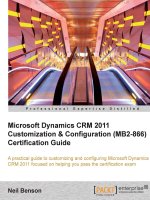

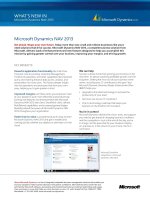
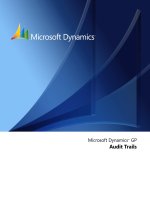
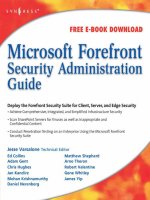
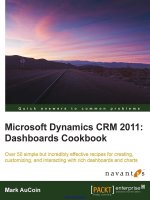

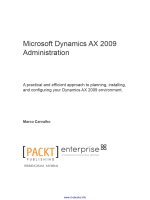
![maximizing your sales with microsoft dynamics crm 2011 [electronic resource]](https://media.store123doc.com/images/document/14/y/ir/medium_irp1401358930.jpg)